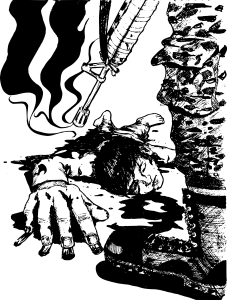Suffering under privatized power transmission


While the Filipino people suffer from poor power transmission services, officials of the National Grid Corporation of the Philippines (NGCP) pocket huge amounts of profits.
On May 8, residents of Metro Manila, neighboring provinces and some parts of the Visayas experienced extreme heat during several hours of widespread brownout because the NGCP grids (cable system and power lines) malfunctioned. According to the company, the power supply was insufficient because five of its grids failed and three others slowed down. This caused massive problems to hundreds of thousands of Filipinos. In Metro Manila alone, 300,000 consumers were affected.
Profit from people’s suffering
The NGCP was established in 2009 to privatize the operation, maintenance and assets of the National Transmission Corporation, a government-owned and -controlled corporation. This was done under the 2001 Electric Power Industry Reform Act (EPIRA).
The then Arroyo regime sold NGCP to a consortium consisting of Monte Oro Grid Resources now controlled by Henry Sy Jr, and Calaca High Power Corporation by Robert Coyiuto Jr. and Pedro Goza. NGCP’s 40% stake was bought by the State Grid Corporation of China, which is owned by the Chinese government. NGCP was awarded a 25-year concession and a 50-year franchise. The consortium paid $3.95 billion to the state, which was quickly recovered in just four years. By 2015, the company had more than doubled its original investment.
In a senate hearing, it was disclosed that NGCP’s income from 2009 amounted to ₱286 billion. Of this, ₱208 billion was given to the company’s shareholders, and not reinvested to develop the transmission infrastructures. The company’s revenue grew due to its high service charge.
Recently, the Energy Regulatory Commission reported the delay of 72 NGCP projects meant to improve its services, including 33 in Luzon, 19 in Visayas, and 14 in Mindanao. In addition, six of the 16 energy projects it identified as having “national significance” were not completed by the corporation. Despite this, the costs for these are already part of what NGCP collects from consumers in the form of “transmission charges” since 2020.
Privatized power sector
Transmission is just one of the privatized part in the power sector. Under EPIRA, a large portion of electricity services, from production, transmission to distribution, are held by private businesses.
The power generation subsector is lorded over by Ramon Ang’s San Miguel Corporation. The company holds 20.76% of the subsector followed by the Aboitiz family’s Aboitiz Power Corporation (APC) with 17.67% and Federico R. Lopez’s FirstGen Power Corporation with 14.12% market control.
In 2022, SMC power subsidiary San Miguel Global Power Holdings Corp recorded a net income of ₱3.1 billion. Meanwhile, APC recorded a 32% growth in its net income to ₱27.5 billion.
Meanwhile, power disitibution is dominated by the Manila Electric Company (Meralco), owned by Manny V. Pangilinan and the Lopez family. In 2022, the company’s net income grew by 21% from ₱23.5 billion to ₱28.4 billion. The company covers nearly 6.5 million customers nationwide while other private companies control distribution in other regions.
When EPIRA was enacted, it promised the provision of cheap and reliable electricity. After more than two decades, power rates are rising and electricity service is poor.
Compared to 2001, power rates have increased by almost 200% from ₱5.76 per kWh to ₱11.4929 per kWh as of May 2023. Latest comparisons made in December 2021 show the Philippines charges the highest power rates in Southeast Asia. In a 2022 data, local rates ($0.173 per kWh) are also higher compared to the global average ($0.168 per kWh).









